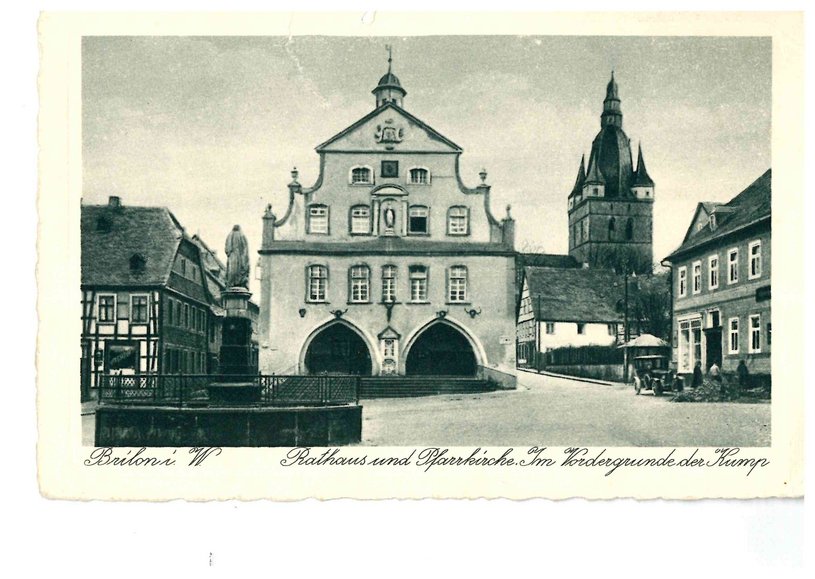Turbulent Times
Basically a town with an historic appearance, Brilon also stands for modern-day tourism and prosperous industry. For centuries the principal place in the former Dukedom of Westphalia, it is situated in the north-eastern part of the Sauerland region, close to the border with Hesse State.
The town's name, first to be found in today's spelling in the oldest document dating from the year 973, appeared in many different notations across the ages: Besides Brilon, we find Brilo, Brielon, Briglon, and most frequently Brylon.
It might derive from the Middle-Low German “bril”, “brul”, or “brol”, denoting a bush-lined meadow or swamp. The ending “-on“ probably corresponds with the High-German place-name ending “-in“ so that the translation of the name in itself could be “In the wetlands”.
More than a thousand years ago, a band of horsemen, struggling to battle their way through the Sauerland highlands, got lost in the vast, dense forests. Luckily, the riders discovered a farmstead and were met with sincere hospitality by the good farmer and his family. The next morning, the guests revealed their true identity: It was Emperor Charlemagne and his retinue. As “Brei-Lohn“, pay for the simple, porridge-like food (still another interpretation of the name “Brilon“, by the way), the farmers received a truly imperial reward from Charles the Great: All the woodland they could ride around on horseback in one day.
Meanwhile, as a result of the 1975 regional and structural reforms and boundary reorganisations, Brilon is a large municipality covering some 230 sq. km, with its maximum expansion of 20 km east to west and north to south, characterised by three very different types of landscape.

Brilon – facts and figures
Population: 27,702 (as of 2019)
Area: 229.01 sq. km (urban core before 1975 municipal restructuring: 97.23 sq. km)
Forest area: 112.16 sq. km (49 %)
Agricultural land and uncultivated area: 93.86 sq. km (41%)
Populated area: 22.95 sq. km (10%)
Maximum expansion
North-South: approx. 20 km
East-West: approx. 20 km
Height above sea level: 796 m max., 282 m min.
Brilon A.D. – Chronology
973 | First authentic mention of the name Brilon in charter granted by Emperor Otto II, dated 4 June |
1220 | Foundation of town by Engelbert, Archbishop of Cologne |
1276 | Consecration of town church |
13th-14th centuries | Member of Hanseatic League. Thanks to industrious traders and craftsmen, Brilon flourishes, numbering some 3,000 inhabitants around 1350 |
1388 | First Brilon Schnadezug Frontier Walk, the traditional border patrol. Since then, the city limits are traditionally patrolled and inspected by the male townspeople every two years |
1417 | The Briloner Schützenstatuten (Charter of the Brilon Rifle Association) are established, the oldest in Westphalia province. |
1444 | Brilon promoted to rank of “Principal Town in Duchy of Westphalia” |
1557 | Brilon made residence of electoral mining authority |
16th century | Brilon considerably expanding her vast estates: numerous acquisitions, rural exodus, purchase of village and court of Altenbüren, 1524 |
1632 | During Thirty Years' War, Brilon conquered and pillaged by the Hessians |
1653 | Foundation of Minorite (friars minor) monastery and school by sovereign |
18th century | Brilon severely damaged in several great fires |
1802-1816 | Brilon under Hessian rule |
1816 | Now under Prussian rule, Brilon is made headquarters of county administration (until 1975) |
1873 | Ruhr River-Valley Railway completed (railway line Hagen – Brilon-Wald – Kassel) |
1905 | Brilon has 5,000 inhabitants |
Early 20th century | Prosperous economic development as a result of several enterprises locating in the area |
1945 | 10 January: allied air raid on town claims thirty-two lives. On 29 March, Brilon taken and occupied by US Army. |
Early 1950s | Village of Petersborn founded, largely by displaced Germans from Silesia |
1974 | Brilon becomes Germany's most richly wooded town, nationally recognised as a climate-health resort |
1975 | Formation of Greater Brilon municipality with now approx. 25,000 inhabitants. Loss of county administration authority |
2000 | Officially acknowledged Kneipp resort |
2016 | Officially acknowledged Kneipp Spa |
